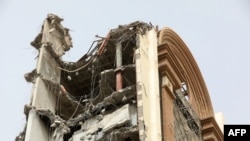On June 4, Supreme Leader Ayatollah Ali Khamenei took up the issue of protests that have erupted in the authoritarian republic since the deadly collapse of a 10-story building in May.
Khamenei’s comments came in speech marking the 33rd anniversary of the death of Ayatollah Ruhollah Khomeini, the regime’s founder, and he put the blame for unrest on outsiders.
“The enemy has counted on public protests to put people against the Islamic Republic, and surely the enemy’s forecast is wrong like its many other ones,” Khamenei said.
That is misleading.
Although Khamenei never named the enemies, it’s generally understood that the term is code for the United States and Western countries that have opposed the repressive regime.
Casting blame elsewhere diverts attention from the real problems that animated protesters, chiefly corruption and skyrocketing food prices.
The May 23 collapse of the Metropol Building in Abadan, a city in Iran’s southwest Khuzestan province, killed at least 38 and injured 37 more, the government said. News reports said that perhaps 80 other people were believed to be trapped under the wreckage.
The building was still under construction when it collapsed. News reports raised concerns about corruption, citing the owner’s connections, and recalled unheeded safety warnings. One analysis by the Middle East Institute said the structure’s vulnerability “was common knowledge:”
“Iranian construction projects have long been criticized by experts for safety violations in a country prone to earthquakes. After the [2017] collapse of Tehran’s Plasco building, the Construction Engineers League, an organization with no executive power, identified at least 170 unsafe buildings in the capital that it deemed to be verging on collapse.
“Moreover, the head of the Iranian fire department recently identified 33,000 unsafe buildings in Tehran. Of these, 360 were described as needing ‘immediate intervention’ while 123 were said to be in a state of disrepair comparable to that of the Plasco building at the time of its collapse.”
Protesters at first demanded that local officials be held accountable for the Metropol collapse.
After the protests expanded to other cities, demonstrators’ fury grew, and they started chanting “Death to Khamenei” and “Death to the Dictator,” according to Radio Free Europe/Radio Liberty, a sister U.S.-funded news organization to Voice of America.
Iranian authorities said they arrested 13 people, including mayors and other officials, for construction violations.
But the building collapse wasn’t the only thing on protesters’ minds.
Iran has been reeling from a deteriorating economy, thanks in part to harsh Western sanctions over its nuclear program. A cut in state food subsidies caused prices to spike by 30% in mid-May, sparking calls for Khamenei’s ouster. Reuters said at least four demonstrators were killed:
“Videos posted online showed demonstrators burned images of Iran's top authority, Supreme Leader Ayatollah Ali Khamenei, and called for the return of Reza Pahlavi, the exiled son of the toppled Shah of Iran.
“Footage on Twitter showed protests in dozens of provinces such as Ardabil, Khuzestan, Lorestan and Razavi Khorasan. Some state-affiliated media, meanwhile, said calm had been restored in the country.
"However, protests continued on early Sunday in at least 40 cities and towns across Iran, including in the town of Quchan near the Turkmen border, the northern city of Rasht and the western city of Hamedan, according to videos posted on social media.”
On May 20, Human Rights Watch (HRW) criticized Iran for the arrest of prominent sociologist Saeed Madani for “meeting suspicious foreign actors and conveying their operating guidelines to entities inside the country.” HRW said Madani had been interrogated and prevented from leaving Iran. In January, he also had been stopped from leaving for a fellowship at Yale University.
“The arrests of prominent members of civil society in Iran on baseless accusations of malicious foreign interference is another desperate attempt to silence support for growing popular social movements in the country,” said Tara Sepehri Far, HRW’s senior Iran researcher.
The rights group also noted the reported arrests of two Europeans, one a French teachers’ union organizer. This followed the arrest of dozens of teachers’ union activists in late April, HRW said.
Iran has a history of brutally handling protests, be it over elections, water shortages or price hikes, even asking payment from families to return the bodies of demonstrators who were killed.





